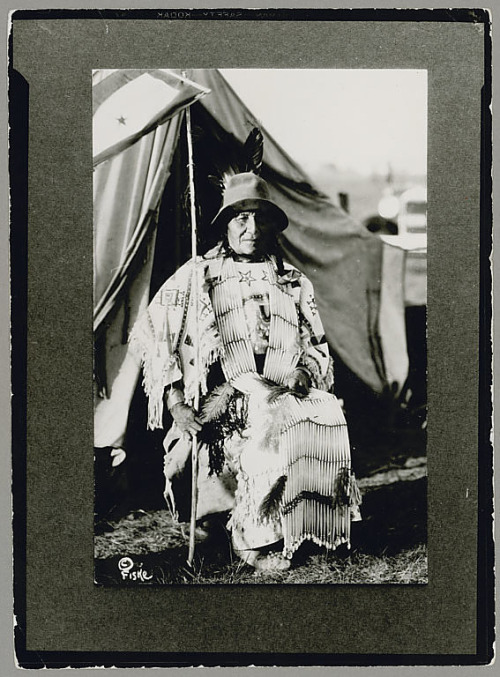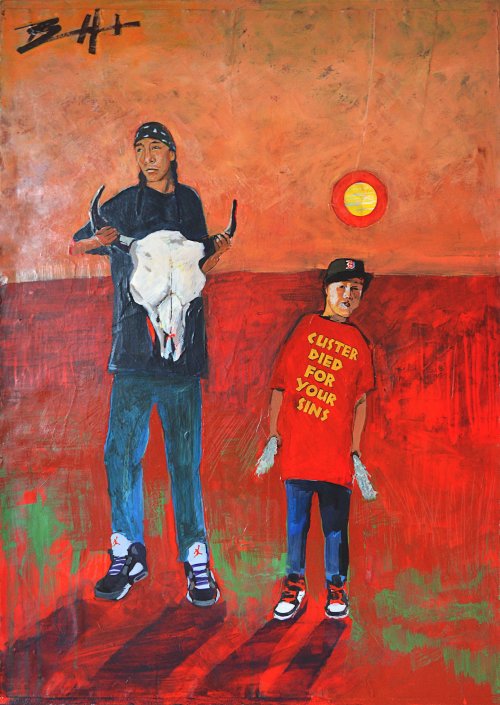#lakota
Challenges and Solutions to Keeping the Lakota Language Alive
“There is more to an immersion school than simply bringing in elders and having them teach the chidren,” said Sunshine Carlow, education manager of Lakȟól’iyapi Wahóȟpifor, the Lakota Nest Immersion School on the Standing Rock Reservation in South Dakota.
Post link
Moving Robe Woman - Hunkpapa heroine
Moving Robe Woman (1854-1935) was a Hunkpapa Lakota woman who fought during the Battle of the Little Bighorn in 1876 to avenge her brother.
Moving Robe Woman was harvesting turnips when she heard that her brother had been killed by the U.S. cavalry. According to an interview conducted in 1931 she did the following thing:
“I sang a death song for my young brother who had been killed. My heart was bad. Revenge! Revenge! For my brother’s death. (…) I ran to a nearby thicket and got my black horse. I painted my face with crimson and braided my black hair. I was mourning. I was a woman, but I was not afraid.
(…)
By this time the soldiers were forming a battle line in the bottom about a half mile away. In another moment I heard a volley of carbines. The bullets shattered tipi poles. Women and children were running away from the gunfire. In the tumult I heard old men and women singing death songs for their warriors who were now ready to attack the soldiers. The enchanting death songs made me brave, although as was a woman. Father led my horse to me and…we galloped toward the soldiers.”
Warrior Rain in the Face recalled that Moving Robe Woman was “pretty as a bird” as she was galloped on her charger, brandishing her brother’s war staff over her head. He said: “always when there’s a woman in charge it causes the warrior to vie with each other to display their valor”.
Moving Robe Woman fought as fiercely as any of the warriors. She killed two of Custer’s troopers: shooting one with her revolver and stabbing the other to death with her knife. She also reportedly shot the badly wounded interpreter Isaiah Dorman. A possible account tells the scene as follow, with him saying:
““Do not kill me, because I will be dead in a short while, anyway.”
The woman said, “If you did not want to be killed, why did you not stay home where you belong and not come to attack us?” The first time she pointed the gun it did not go off, but the second time it killed him.”
The battle ended in Custer’s death and a temporary victory. Moving Robe Woman died in 1935. She concluded her interview by saying:
“In this narrative, I have not boasted of my conquests. I am a woman, but I fought for my people. The white man will never understand the Indian. Eyas Hen La! I have said everything!”
Warrior women of the Little Bighorn:
Bibliography:
“Eagle Elk’s story of the battle of the Little Bighorn”
Hall Alan R., A Man Called Plenty Horses, The Last Warrior of the Great Plains War
Hardoff Richard G., Lakota Recollections of the Custer Fight, New Sources of Indian-military History
Lawson Michael L., Little Bighorn, Winning the Battle, Losing the War
Philbrick Nathaniel, The Last Stand, Custer, Sitting Bull and the Battle of the Little Bighorn
Post link
Minnie Hollow Wood and One Who Walks With the Stars - Lakota warriors
Minnie Hollow Wood (c.1856-1930′s) was a Lakota woman and wife to chief Hollow Wood. In 1876, she fought at the battle of Little Bighorn, which ended in a victory of the native tribes against the U.S. army. Minnie distinguished herself when fighting against the U.S. cavalry and was awarded the right to wear a war bonnet.
The tide later turned, and she and her husband surrendered to general Nelson Miles. In 1877, she was among the prisoners at Fort Keogh. She and her husband were later transferred to a reservation where they lived the rest of their lives. The above photograph was taken in 1930 when Minnie Hollow Wood was 74.
Oglala Lakotawoman One Who Walks With the Stars also resisted Custer’s soldiers. She was the wife of Brulé Lakota (or possibly an Oglala) chief Crow Dog. Her story was preserved by survivors of the fight. While her husband didn’t kill anyone during the battle, she killed two soldiers who tried to swim across the river.
Warrior women of Little Big Horn:
Bibliography:
Hirschfeld Arlene, Paulette F. Molin, The Extraordinary Book of Native American Lists
Lawson Michael L., Little Bighorn Winning the Battle, Losing the War
Liberty Margot,”Cheyenne Primacy: The Tribes’ Perspective As Opposed To That Of The United States Army; A Possible Alternative To “The Great Sioux War Of 1876″
Miller Humphrey David, Custer’s fall
Wakim Dennis Yvonne, Native American Almanac More Than 50,000 Years of the Cultures and Histories of Indigenous Peoples
Post link




